Building Block Furniture Umich
1837:
The state approves the University's move from a single building in Detroit to a plot of donated land in Ann Arbor. The first classes were held in 1841.
1848:

U-M launches its Medical Department in response to a petition from local physicians, and a study committee chaired by Zina Pitcher, M.D., a member of the Board of Regents. The initial approval allows for three faculty and $3,000 to build a medical building. U-M is the first university to make its medical school a full part of the university, with physicians as faculty, and sets out to make the school "an example worthy of imitation."
1850:
The Medical School opens its doors to 90 first-time medical students, and five seeking additional training. They attend lectures in a building modeled after a Greek temple located on the Diag, where the Randall Laboratory stands today. For tuition of $5 a year, they get four lectures a day Monday through Friday from October to April. Each Saturday morning, they watched a clinical demonstration of a medical condition or operation, led by faculty and involving a patient from the local community who agreed to appear before the class in exchange for free treatment. To graduate, they had to go through the curriculum twice, write a thesis and work as an apprentice to a local physician between terms.
1851:
The first few medical diplomas are awarded, to a handful of students who had entered the school with some medical training.
1852:
The first full class of physicians graduates.
1856:

A Chemical Laboratory – the first building at any U.S. university devoted to chemistry – opens behind the Medical Building. Medical students, and other students, learned chemical analysis and preparation of medications, which many practicing physicians at the time had to do themselves.
1857:
Despite the efforts of some faculty to move the Medical School to Detroit in order to give students access to hospitals for training during their summer months, U-M decides to keep the school in Ann Arbor.
1860:
U-M ends a short-lived summer clinical training program in a Catholic hospital in Detroit for its medical students.
1861:
A proposal to turn a professor's house into a hospital is turned down for lack of funds.
1863 and 1864:
With the Civil War raging, faculty ask the federal government for funds to build a military hospital on the U-M campus. They are turned down.
1865:

To keep up with the rising demand for medical education, the Medical Building more than doubles the size of its space, with a four-story addition to the original columned 1850 building that contained a new space for anatomical dissection and two 600-seat "theaters" for lectures and clinical demonstrations. The addition was funded in part by donations from the citizens of the City of Ann Arbor.
1867:

The Medical School's 525 students make up a large part of U-M's 1,255-member student body.
1868:
With 300 patients turning to U-M professors for care, the faculty petition the Regents for a new or expanded hospital.
Spring 1869:

The state legislature approves funds for the conversion of an existing U-M building into a hospital. It was one of the first buildings built for U-M in Ann Arbor, and had served as a university-owned house for professors since 1840. It stood on North University Ave., on the spot where the current Chemistry building stands, on the east side of the walkway leading north from the Diag.
Fall 1869:
As the hospital prepares to open, the Regents accept a report from the medical faculty stating that "the general management of the hospital shall be under the control of the medical faculty, and the management of patients shall be under the control of the hospital staff." Edward Carrington was appointed janitor of the hospital, living with his family in the basement and two rooms of the first floor. He's paid 75 cents a week for every patient admitted to the wards, to cook and clean for patients, and keep the fires lit. The hospital is ready by October – except no money has been allocated for medicines.
December 1869:
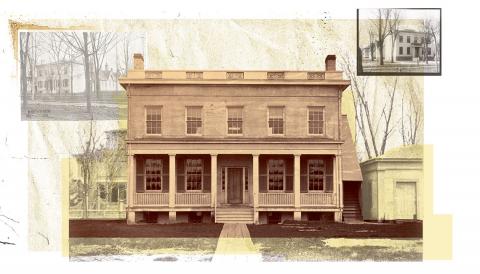
After spending $55.37 on medicines, the 20-bed hospital opens. It is the first university-owned medical facility in the United States; in 1873 the University of Pennsylvania opened the first purpose-built hospital at a university.
Read more about it in this story.
January 1870:
The first report to the Regents about the hospital's operations states that "The organization of a Hospital in connection with the University, although at first deemed an experiment of doubtful success, thus far promises well as a means of valuable clinical teaching, with little expenditure for current expenses beyond that provided for through fees from patients." It had already brought in $275.78 after spending $905.78 on furniture, appliances, medicines and other expenses. "This certainly is deemed a very favorable exhibit for such an experiment in an inland city." But they asked to raise the price of board to $5 a week.
March 1870:
The Regents are asked to consider the education of women as medical students, but on the condition that the female students receive some aspects of their education separate from male students, or that a separate women-only medical college be established.
By now, the hospital had been outfitted with running water, and expanded to 20 beds with plans for three more. But the report to the Regents already began to make the case for building a much larger hospital, of 500 to 1,000 beds.
July 1870:
The Board of Regents formally approves the education of women as medical students, providing additional funds to compensate professors for teaching extra lectures to female students.
1871:

The Medical School's first female graduate, Amanda Sanford, receives her degree. She had entered a year before, when the Medical School became the first major school to accept women. The first full class of women medical students – 17 out of a student body of 315 -- is said to have "taken rank at once among the best students."
1872:

William Henry Fitzbutler, M.D.
The Medical School graduates its first African-American student, W. Henry Fitzbutler. Born the son of a slave, he had traveled to Canada with his family via the Underground Railroad. After graduation, he went on to found a medical school and hospital for African-Americans in Louisville, Kentucky. One of the four 'houses' to which U-M medical students now belong is named for him.
Six women also graduate in this year; their names are listed after the male students' names and they are not included in the official class photo.
1874:

After just a few years of educating female medical students separately from men, the decision is made to combine the classes. The first formal entrance examinations for medical students are required.
1875:

A total of 221 patients were treated at U-M in the 1874-1875 academic year, and 185 of them stayed at the hospital, for an average of three weeks each.
The state and city approve a total of $14,000 for an expansion of the current hospital, and by September U-M began adding two 114-foot-long wooden pavilions to the hospital, extending from the south side of the first hospital. The structure is designed to be "easily burned down in 10 years because it would be badly infected," according to the writings of one physician.
1876:

The new hospital opens, and the first staff nurses are hired. All care is provided for free, though patients are charged for room and board.
1877:
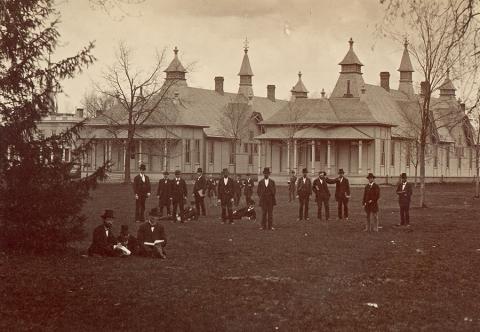
With the new hospital open, 244 inpatients and 350 outpatients come for care, a new record for clinical activity. The faculty ask the Regents for the ability to hire staff to run it, and a matron and resident surgeon are soon hired with the ability to hire further nursing help.
1878:
The Medical School year is extended to nine months. A Pathological Laboratory opens.
1879:
An operating room is built within the hospital, followed in 1881 by a ward for eye and ear patients. At the same time, U-M builds its first homeopathic hospital, for the students of the controversial homeopathic medical school.
1880:
The Medical School adopts a three-year curriculum, allowing students to receive clinical training. The school also introduces laboratory instruction and assigns grades for the first time. Faculty perform 240 operations in the new amphitheater, including on patients who had cancer.
1881:
U-M physicians begin treating children covered by state programs for the poor and seriously ill.
1885:

Sophia Bethena Jones, M.D.
Sophia Bethena Jones, M.D., becomes the first African-American woman to graduate from the U-M Medical School. She came to Michigan from Canada, frustrated with the University of Toronto's limited medical training program for women. After graduation, she became the first African-American to join the faculty of Spelman College, and established its nurse's training program before going on to practice medicine in St. Louis, Philadelphia and Kansas City.
1887:
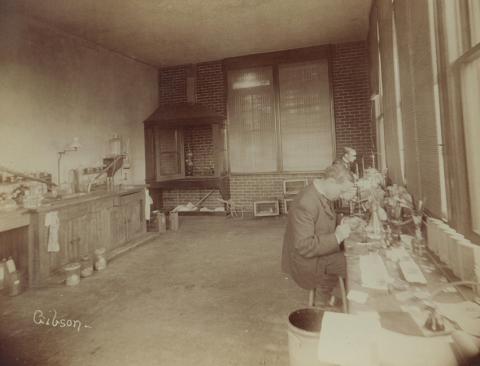
A Hygienic Laboratory, the first building in the country where students could learn the new science of bacteriology in a systematic way, opens under the direction of Victor Vaughan. The laboratory also serves the state by analyzing food and water for bacterial contamination – allowing scientific investigation of public health outbreaks.
1889:

A dedicated building for anatomical training opens, including a separate area for female students known as "hen medics."
The state and city approve funds for the construction of a new hospital, on Catherine Street.
1890:
U-M adopts the four-year medical school program still in use today.
1891:

Two stone hospital buildings open on Catherine Street – the eastern one with 65 beds for the main Medical School and the western one with 40 beds for the homeopathic school. They stood on the site where the Taubman Health Sciences Library and Medical Science II building entrances stand today. All patients receive care for free from the 27 Medical School professors and the staff.
The first six nursing students are admitted to the two-year program of the new U-M Training School for Nurses.
John Jacob Abel becomes the first medical professor at U-M, and one of the first in the nation, to devote his time fully to research and education.

A Laboratory of Clinical Investigation is established, to study disease and teach diagnosis to students.
1892:
The first clinical pharmacist, James Perry Briggs, Ph.C., is hired. In addition to being in charge of preparing medicines, he was responsible for preparing instruments and sutures for surgical teams, and took the first X-rays.
1897:
The hospital begins to operate year-round, not just when the Medical School class sessions are under way.
A house is converted into a Contagious Hospital, on the site of the current Medical Science I building.
1899:
The Medical School introduces the nation's first clinical clerkship, requiring third-year medical students to take part in the care of hospitalized patients.
The first Hospital Laundry opens.
1900:
The U.S. medical community recognizes the Catherine Street Hospital as the largest teaching hospital in the country.
The homeopathic hospital is moved to main campus, and its former building is converted into the West Medical Ward while the main hospital building becomes a Surgical Ward.
1901:
The first dietitian is hired.
1902:
The Department of Bacteriology – the first of its kind in the nation – is founded. It's the forerunner of today's Department of Microbiology & Immunology.
1903:
Two major new buildings open: The Palmer Ward on Catherine Street, and the new West Medical Building on the Diag.

Located between the two main hospital buildings, the Palmer Ward is devoted to the care of children whose illness is serious enough to place them in state care, and at first also includes care for women during childbirth. It was made possible by a gift from the widow of former dean Alonzo Palmer. It also contained the first radiology (then known as Roentgenology) facility for medical imaging.

The West Medical Building was built just north of the first Medical School building, to replace and expand facilities for teaching and research. It is still in use today as the Dana Building of the School for Environment and Sustainability.
1906:
The U-M Department of Psychiatry, one of the nation's first such academic departments, is established. The Psychopathic Hospital, the first state-owned mental care hospital affiliated with a university, opens on what is now the western side of the Medical School circle drive. It operates in close partnership with the university.
1908:

The maternity ward moves into its own building, a frame house behind the hospital.
1909:
The city service that becomes Michigan Visiting Nurses is launched to serve the needs of U-M patients.
1910:
The Medical School takes over the entire Chemistry Building, to provide space for physiology and pharmacology.
1912:

U-M establishes the nation's first Department of Dermatology. It moves into a frame house on the current site of MSRBIII in 1918.
The first social worker is hired.
The Training School for Nurses is placed under control of the University Hospital administration.
1913:
U-M researchers introduce the electrocardiogram (EKG) to American physicians.
Free admission to the Palmer Ward is offered to all children with serious illness, not just those in state-funded programs.
1914:

A larger Contagious Hospital is built, and operates until 1956, on the site where the current Medical Science I east wing stands.
The first housing for interns – young physicians fresh from medical school – opens.
1915:
The Board of Regents officially sets the name of the medical branch of U-M as the Medical School. Until this time, it was officially called the Department of Medicine and Surgery, even though it also had units within it that called themselves departments.
1917:
One of the nation's first Departments of Radiology (then called Roentgenology) opens.
1919:
The School of Dentistry forms a partnership with the Medical School for oral surgery care and training.
1921:
U-M establishes Pediatrics and Infectious Diseases as an independent department, strengthening the University's focus on children.
1922:
To help children learn and cope with their experience in the hospital, the nation's first hospital school program is founded by teacher Ruby Carlton. It is now part of Child & Family Life.
1925:

The new 600-bed, 13-story University Hospital (also known as the Main Hospital, and later "Old Main") opens, to greatly expand the cramped facilities of the Catherine Street building cluster. Designed by renowned architect Albert Kahn, it was the largest university hospital in America at the time, and was full from the day it opened. Its half-million gross square feet included wards, private rooms, a surgical wing with eleven operating rooms, clinical laboratories, a pathology museum, lecture rooms, two miles of corridors, and a central heart station with wires running to all clinical departments. With its opening, the former Surgical Ward building becomes a Convalescent Ward.

The Medical School opens its East Medical Building, with advanced facilities for teaching and research in anatomy, bacteriology, histology and more. This building still stands as 1100 N. University Ave., the home of the Department of Earth and Environmental Sciences.
The Couzens Hall dormitory opens as a home for student nurses. Marjorie Franklin, who had enrolled in 1924 as the first African-American student at the U-M Hospital School for Nurses, is permitted to move in, after fighting for the right to receive university-provided housing that she was initially denied because of her race.
1926:

The Simpson Memorial Institute, originally devoted to the search for a cure for the fatal condition known as pernicious anemia, opens. After a U-M team discovers a treatment, the building becomes a hub for clinical research on many blood-related illnesses.
With the closure of the Homeopathic Hospital and Medical School, its former building is converted to the "South Department" hospital, and used until 1940. It was later used by ROTC until its demolition for the Biosciences and Museum of Natural History building.
1928:
University Hospital offers the first physician training program in thoracic surgery. Four years later, U-M physicians perform the world's first successful lung removal.
1929:
Physicians across the state of Michigan begin turning to U-M for post-graduate education to receive additional training in their field of specialty. This is now called Continuing Medical Education.
1934:

The first statistical department, for recording patient data and providing access to it, is established.
1937:
The Psychopathic hospital is converted into the East Hospital, and in 1944 becomes the Beal Residence for patients receiving extended outpatient care at the hospitals.
1938:

The Victor Vaughn House opens as a dormitory for male medical students on the former site of the Homeopathic Hospital on Catherine Street.
The Neuropsychiatric Institute opens, north of the main hospital. U-M took over the ownership and running of the inpatient and outpatient clinics from the state of Michigan, and provided modern facilities for the same patient population that had been treated at the Psychopathic Hospital, including an increased number of adolescents.
The first Blood Bank opens in the main hospital.
1939:

A Surgical Wing is added to the main hospital, adding operating rooms and inpatient beds as well as pathology facilities and amphitheaters. The brings U-M's total inpatient capacity to 1,350 beds.
1940:

U-M creates the first human genetics program in the United States, and the nation's first hereditary diseases clinic at University Hospital.
The modern era of federally funded research at universities gets under way, with $137,000 in funding coming to U-M in this year.
1941:
The U-M School of Nursing is fully established as a health science academic unit of the University, though it operates under the direction of a committee of hospital and Medical School leaders until the first dean is named in 1955.
1950:

The U-M Women's Hospital opens its doors, with 74 beds and 40 bassinets, two delivery rooms, an operating room and research facilities. The building, located east of the 1925 University Hospital, is still in use today as offices.
The medical research budget has grown to more than $500,000 by this year.
1951:
The four-year program leading to the Bachelor of Science in nursing is established.
1952:

The Outpatient Building, devoted to patients who did not need overnight care, opens near the main hospital. It is still in use today as the MedInn Building. Its opening allows the main hospital to begin offering 24-hour emergency care.

Albert Wheeler, Ph.D.
Albert Wheeler, Ph.D., becomes U-M's first African-American faculty member, when he joins the Department of Microbiology and Immunology. After seven years leading a laboratory studying the bacterium that causes syphilis, he took a leave of absence to launch a second career in social activism and politics, including a term as Ann Arbor's mayor in the 1970s.
1953:

A Veterans Administration hospital opens on Fuller Road, less than a mile from the U-M medical campus. Through a partnership that continues today, faculty physicians, medical students and residents provide care for veterans, and conduct research on veterans' health issues.
1954:

The Kresge Research Building opens, on Zina Pitcher and Ann Street. It contains modern research laboratories.
1955:
The Child and Adolescent Psychiatric Hospital opens.
1956:
A new Medical Library opens in an addition to the Kresge building, bringing together the collections of the Medical School, Hospital and Nursing School.
1958:

The Medical Science I building opens, marking the Medical School's first administrative and research building on the medical campus, and a new facility for the School of Nursing.
1959:
The U-M Burn Center is created – the first dedicated burn unit in Michigan and one of the first in the U.S.
The first African-American professor to receive tenure at U-M is Albert Wheeler, Ph.D., in the Department of Microbiology and Immunology.
The first hospital gift shop, run by the Volunteer Services Guild, opens. It's now run by the all-volunteer Friends of the University Hospital, which provides grants for patient and family activities using the proceeds from sales.
1964:
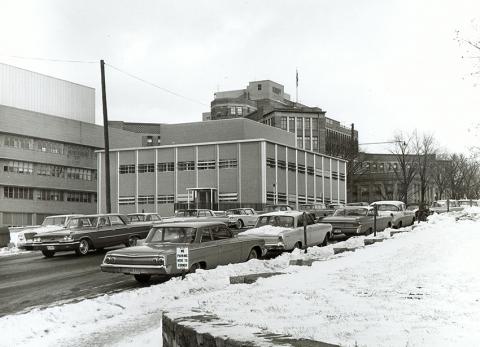
The Kresge Hearing Research Institute building, adjacent to the main Kresge building, opens. The complex stood where the new inpatient hospital facility will be built by 2024.
1968:
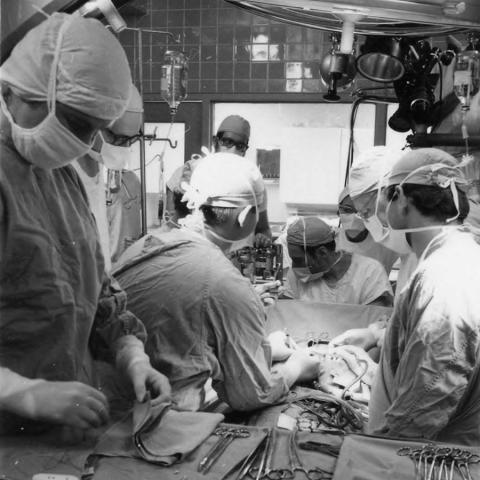
U-M physicians perform the first heart transplant in Michigan.
1969:

C.S. Mott Children's Hospital opens, providing enhanced dedicated space for children, who had previously received care in wards of Old Main hospital.
The Medical Science II building opens with facilities for several research and education departments, marking the final part of the Medical School to move off of the Diag.
1972:
U-M builds the James and Lynelle Perinatal Holden Hospital (now called the Holden Newborn Intensive Care Unit ) to care for premature and critically ill infants.
1974:
The Riverview Psychiatric clinic opens on Wall Street. It's joined by the Turner Geriatric Clinic in 1976.
1975:
One of the nation's first Ph.D. programs in nursing research is established at the School of Nursing.
1976:
U-M establishes the W.K. Kellogg Eye Center, a 32-bed inpatient facility providing patient care, education and research in eye diseases.
1977:

The relocation of the St. Joseph Mercy Hospital from North Ingalls Street to Ypsilanti Township leads to the university's purchase of the building, and conversion into administrative space for the hospital, research and office space for Medical School departments.
1984:
Survival Flight begins flying medical missions by helicopter.
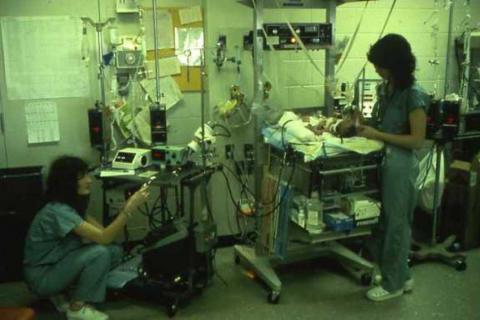
The first patient is treated at U-M with ECMO – extracorporeal membrane oxygenation – to provide life support for both heart and lung functions. While this technology had already been tried at other hospitals, the U-M team headed by Robert Bartlett, M.D., developed its use.
1985:
A new Kellogg Eye Center building opens, with outpatient care and research.
1986:
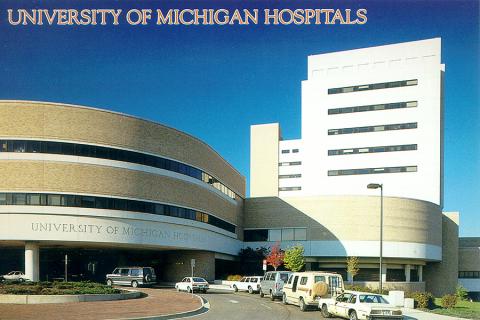
A new 11-story, 550-bed adult general University Hospital replaces the old University Hospital. The A. Alfred Taubman Health Care Center, which houses 120 outpatient clinics, is connected to the facility.
An insurance plan called M-CARE is created by U-M and licensed by the state of Michigan; it is one of the first university-owned HMOs in the U.S.

The first of three Medical Science Research Buildings opens on the site of some of the former Catherine Street clinical buildings. The other two open in 1989 and 1995.
The first U-M space at the Domino's Farms complex in northeast Ann Arbor opens; today numerous clinics and research units have space there.
1989:
The School of Nursing moves into a portion of the North Ingalls Building complex.
The Livonia Center for Specialty Care opens, bringing outpatient surgery and specialty care to the Western Wayne County area. The Dexter Health Center opens in western Washtenaw County.
The Geriatrics Center, one of the first in the nation, is created.
1990:

The Maternal Child Health Center, which integrates services for children and women, opens with both new space and renovated units in existing Women's and Mott hospitals.
1995:

Five buildings near Briarwood Mall are purchased by U-M for outpatient facilities; more are added in 1996. The Saline and Chelsea Health Centers open.
1996:
The East Ann Arbor Health Center opens on Plymouth Road near US-23, the first building on what will become the East Medical Campus. The Ypsilanti Health Center opens.
1997:
The U-M Board of Regents officially approves "University of Michigan Health System" as a designation for the U-M Hospitals and Health Centers, Medical School, M-CARE and Michigan Health Corp.
The U-M moves its cancer and geriatrics clinical and research programs into the $88 million Cancer Center and Geriatrics Center Building. The Howell Health Center opens.
1998:
The Livonia Health Center and Canton Health Center open, expanding U-M's reach in the fast-growing Western Wayne County area.
Michigan Visiting Nurses becomes part of U-M.
2003:
The Medical School begins to implement a new curriculum that integrates biomedical, clinical and psychosocial sciences with clinical skills and professionalism.
2005:
The C.S. Mott Foundation provides a $25 million grant for a new children's and women's facility.
The Life Science Institute opens, as a separate academic entity but with many of its faculty jointly appointed in the Medical School.
2006:
The East Ann Arbor Ambulatory Surgery and Medical Procedures Center and Rachel Upjohn Building (including the U-M Depression Center) open on the East Medical Campus.
The Biomedical Science Research Building greatly expands Medical School research capacity, and is organized by research themes rather than department lines, with flexible laboratory space.
2007:
The U-M Cardiovascular Center's clinical building opens, providing a new home for much of U-M's heart, vascular and stroke care for adult patients.
The Geriatrics Center moves to the East Medical Campus.
Retail pioneer Alfred Taubman gives $22 million to create the A. Alfred Taubman Medical Research Institute and to support fundamental research into a wide range of human disease.
The Center for Health and Research Transformation, a joint venture with Blue Cross Blue Shield of Michigan, is formed as a result of the 2006 M-CARE sale.
2008:
The clinical activities of the top-ranked U-M School of Nursing become part of the U-M Health System.
All three U-M hospitals and many clinical units complete their transition to an entirely computerized order entry system called UM-CareLink.
The Faculty Group Practice takes on responsibility for ambulatory (outpatient) care as part of an ongoing effort to integrate the Medical School and the Hospitals & Health Centers, and to increase efficiency and coordination across the Health System.
2009:
U-M purchases the former Pfizer campus in northeast Ann Arbor, names it the North Campus Research Complex, and begins converting it into a vibrant hub for staff & scientists from UMHS and other areas of the University.
UMHS receives a $15 million gift from the Ted and Jane Von Voigtlander Foundation to support the construction of a new women's hospital, which will be named the University of Michigan Von Voigtlander Women's Hospital.
2010:
The new Brehm Tower at the W.K. Kellogg Eye Center increases the capacity to provide advanced eye care for a growing aging population and unites diabetes researchers as they search for a cure.
The Kresge Complex, no longer suited for modern medical research, is demolished and remains a green space until the approval of a new inpatient tower.
2012:
A master affiliation agreement with the Michigan hospitals of Trinity Health is signed.
The already close relationship with the VA Ann Arbor Healthcare System grows closer with the move of VA researchers to the North Campus Research Complex.
The first phase of the comprehensive electronic health information system known as MiChart goes online, and makes possible a new Web-based patient portal.
Two Accountable Care Organizations, the U-M Pioneer ACO and POM-ACO, are formed, putting UMHS at the forefront of health care reform.
Survival Flight's three new helicopters take to the sky.
The Department of Biomedical Engineering becomes a joint department of the Medical School and College of Engineering.
2013:
An affiliation with MidMichigan Health is signed.
The Trinity affiliation leads to the opening of new U-M-managed inpatient beds in Chelsea Community Hospital and Saint Joseph Mercy-Ann Arbor Hospital.
The Cardiovascular Center is named in honor of Samuel and Jean Frankel, whose foundation provided early support of the CVC's innovative model for caring for people with cardiovascular disease.
2014:
The new Northville Health Center, providing outpatient care and ambulatory procedures, opens.
2015:
A new building for the School of Nursing opens.
The Taubman Health Sciences Library building reopens as a hub for U-M health professions and biomedical education, with books available on demand from an off-campus location.
An Emergency Critical Care unit – one of the first of its kind in the country – opens in University Hospital.
2016:
Grand Rapids-area Metro Health and U-M embark on a new affiliation to bring increased health care innovation to west Michigan and beyond.
2017:
The name Michigan Medicine makes its debut, as the designation for the entire U-M academic medical enterprise combining patient care, education and research.
The West Ann Arbor Parkland Plaza Health Center opens.
2018:
A large portion of Clinical Pathology operations moves to the North Campus Research Complex, providing expanded space for advanced diagnostics while freeing up space in University Hospital.
The Brighton Center for Specialty Care opens.
A new joint venture at Saint Joseph Mercy Chelsea hospital expands access to inpatient and surgical care.
2019:
Ground is broken for a new 12-story, 264-bed hospital tower on Zina Pitcher Place at Ann Street that will improve access to surgical specialty care and allow all Michigan Medicine inpatients to have a private room.
Building Block Furniture Umich
Source: https://www.uofmhealth.org/history

0 Response to "Building Block Furniture Umich"
Post a Comment